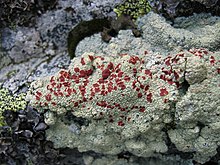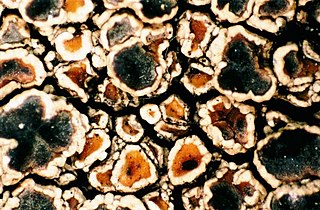
Megasporaceae are a family of fungi belonging to the order Pertusariales. Taxa are lichenized with green algae, and grow on rocks, often in maritime climates close to fresh water. Phylogenetic analysis has shown that this family is related to the Pertusariaceae, another family of lichens. The genus Aspicilia was moved here from the Hymeneliaceae.

The Arthoniales is the second largest order of mainly crustose lichens, but fruticose lichens are present as well. The order contains around 1500 species, while the largest order with lichenized fungi, the Lecanorales, contains more than 14000 species.

The Pannariaceae are a family of lichens in the order Peltigerales. Species from this family have a widespread distribution, but are especially prevalent in southern temperate regions.

The Lecanoraceae are a family of lichenized fungi in the order Lecanorales. Species of this family have a widespread distribution.
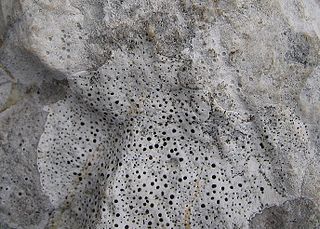
Verrucariales is an order of ascomycetous fungi within the subclass Chaetothyriomycetidae of the class Eurotiomycetes. Although most of the Verrucariales are lichenised, the family Sarcopyreniaceae consists of 11 species of lichenicolous (lichen-dwelling) fungi.

Pilophorus is a genus of lichen-forming fungi in the family Cladoniaceae. They are commonly known as matchstick lichens. The genus has a widespread distribution, especially in temperate regions, and contains 11 species. The genus was circumscribed by Theodor Magnus Fries in 1857, with Pilophorus robustus assigned as the type species.
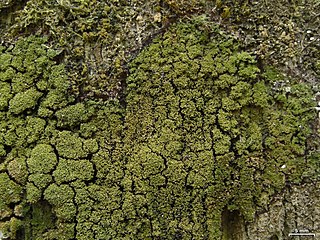
Phyllopsora is a genus of lichen-forming fungi in the family Ramalinaceae. It was circumscribed by Swiss botanist Johannes Müller Argoviensis in 1894, with Phyllopsora breviuscula assigned as the type species.
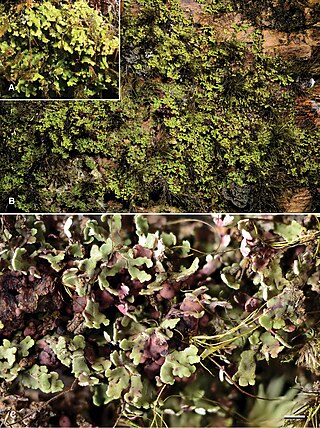
Krogia is a genus of corticolous lichens in the family Ramalinaceae. It occurs in tropical humid forests and rainforests. The genus was circumscribed by Norwegian lichenologist Einar Timdal in 2002, with Krogia coralloides assigned as the type species.
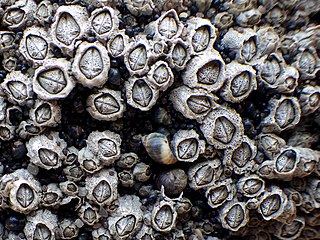
Xanthopyreniaceae is a family of lichen-forming fungi in the order Collemopsidiales. The family was circumscribed by lichenologist Alexander Zahlbruckner in 1926.

The Umbilicariales are an order of lichenized fungi in the subclass Umbilicariomycetidae, class Lecanoromycetes. It contains five families: Elixiaceae, Fuscideaceae, Ophioparmaceae, Ropalosporaceae, and Umbilicariaceae. Umbilicariales was proposed as a new order in 2007, while the subclass Umbilicariomycetidae was proposed in 2013.

The Lecideaceae are a family of lichens in the order Lecideales. It contains about 30 genera about roughly 250 species. A major distinguishing characteristic of the family is the lecanoroid form of the fruiting bodies: typically circular, dark, and without a thalline margin. Most species in the family are lichenised with green algae, although a few species, scattered amongst several genera, are lichenicolous–they live on other lichens. Lecideaceae lichens tend to grow on rocks, wood, and soil. The largest genus in the family, Lecidea, was once a loosely circumscribed wastebasket taxon containing hundreds of morphologically similar species with generally crustose thalli, photobiont-free apothecial margins and translucent, single-celled ascospores. The overall taxonomy and classification within the family has been made more accurate with recent molecular phylogenetics studies.

Hypocenomyce is a genus of lichen-forming fungi in the family Ophioparmaceae. Species in the genus grow on bark and on wood, especially on burned tree stumps and trunks in coniferous forest. Hypocenomyce lichens are widely distributed in the northern hemisphere.

Malmideaceae is a family of crustose and corticolous lichens in the order Lecanorales. It contains eight genera and about 70 species.

Trapeliaceae is a family of lichens in the order Baeomycetales. The family contains 12 genera and about 125 species.

Opegraphaceae is a family of lichen-forming and lichenicolous fungi in the order Arthoniales. It was originally proposed by German lichenologist Ernst Stizenberger in 1862. It fell into disuse, but was resurrected in a molecular phylogenetic study of the order Arthoniales published in 2010. It now includes taxa that were previously referred to the family Roccellaceae, its sister group.
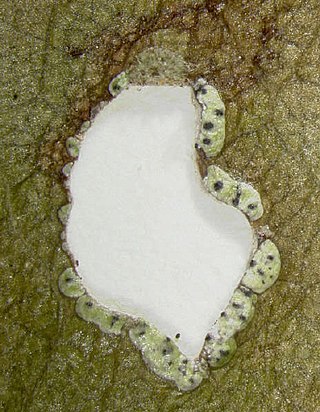
Strigulaceae is a family of lichen-forming fungi, one of two families in the order Strigulales. Recent (2020) molecular analysis of the type genus, Strigula, has led to a reallocation of the foliicolous species into six genera that correspond to well-delimited clades with diagnostic phenotype features.
Toensbergia is a genus of lichen-forming fungi in the family Sporastatiaceae. The genus was circumscribed by Mika Bendiksby and Einar Timdal in 2013. The genus name honours Norwegian lichenologist Tor Tønsberg, "in appreciation of his important work on sorediate, corticolous lichens". The type species is Toensbergia leucococca, which was formerly classified in genus Hypocenomyce, presumably due to its resemblance to Hypocenomyce xanthococca.
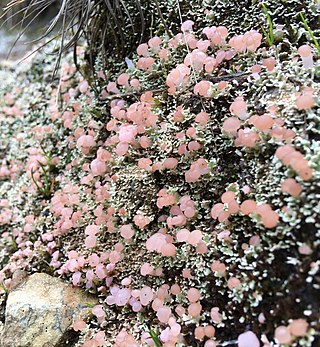
Phyllobaeis is a genus of lichen-forming fungi in the family Baeomycetaceae. It has six species. The genus was circumscribed by lichenologists Klaus Kalb and Claudia Gierl in 1993, with Phyllobaeis imbricata assigned as the type species. Phyllobaeis differs from Baeomyces by the production of the secondary chemical norstictic acid, as well as the tropical distribution of its species. Most species have a squamulose thallus, but the most recent addition to the genus–the Chinese species P. crustacea–has a crustose thallus.

Strigulales is an order of lichen-forming fungi in the class Dothideomycetes. It contains two families: Strigulaceae and Tenuitholiascaceae, with a combined total of 115 species. The order was proposed by Robert Lücking, Matthew Nelsen, and Kevin Hyde in 2013. Most species in the order are foliicolous, that is, they grow on plant leaves.
Timdalia is a fungal genus in the family Acarosporaceae. It is a monotypic genus, containing the single species Timdalia intricata, a saxicolous (rock-dwelling), crustose lichen. This species was first formally described by Swedish lichenologist Adolf Hugo Magnusson in 1935, based on a collection made by Eduard Frey in Austria. It was initially classified in the genus Acarospora. Josef Hafellner circumscribed Timdalia to contain the species in 2001. It was initially placed in the family Lecanoraceae, but molecular phylogenetic studies showed Timdalia to belong in the Acarosporaceae. The genus name honours Norwegian lichenologist Einar Timdal.
